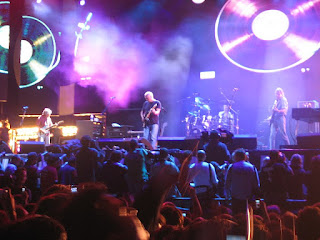Pink Floyd live performances
Pink Floyd were among the first bands to use a dedicated travelling light show in conjunction with their performances.[citation needed] During the Barrett era, dynamic liquid light shows were projected onto enormous screens behind the band while they played, and the band also incorporated large numbers of strobe lights, which were controlled manually by an engineer. This had the effect of totally obscuring the band itself, except for their shadows, which Barrett took advantage of: he would hold his arms up during parts where he was not required to play, making his shadow grow, shrink and undulate, adding to the visual spectacle. They developed many of these lighting techniques through their early association with light artist Mike Leonard.
When psychedelia fell out of fashion from around 1970 onwards, elevated platforms of the type conventionally used for roof maintenance in high buildings were brought on tour and filled with lighting equipment to be raised and lowered during performances. Following Roger Waters' departure in 1985, the Pink Floyd light show reached a pinnacle. Marc Brickman, the group's lighting designer, utilized hundreds of automated intelligent lighting fixtures and lasers, which were state-of-the-art at the time. By the 1994 Division Bell tour, the band was using extremely powerful, isotope-splitting copper-vapour lasers. These gold-coloured lasers were worth over $120,000 a piece and previously had only been used in nuclear research and high speed photography.[2][3]
A large circular projection panel dubbed "Mr Screen" first made an appearance during performances of Dark Side of the Moon in 1974 and became a staple thereafter. The high quality, extreme wide angle projection required special high-speed, 35mm, 10,000 watt xenon film projectors, with custom lenses, all designed, built and toured by Associates & Ferren. Specially recorded films and animations were projected onto it, and for the 1977 "In the Flesh" and 1980–1981 "The Wall Live" tours, coloured spotlights were fixed around the rim, an effect which reached its zenith with the dancing patterns of multi-coloured lights in the A Momentary Lapse of Reason and Division Bell tours. In the latter, the screen could be retracted behind the stage when not required, and was tilted horizontally with its peripheral lights focused onto the stage into a single spotlight during the final guitar solo in "Comfortably Numb".
Several generations of giant glitter balls began with the Dark Side of the Moon tour. By the Division Bell tour, the ball had evolved into a globe 4.9 metres in diameter, which rose from the mixing station to a height of 21.3 metres before opening into an array of petals 7.3 metres wide during the final guitar solo of "Comfortably Numb",[4] revealing a 12 kilowatt Phobeus HMI lamp inside.[2]
Props and pyrotechnics[edit]
Pyrotechnics (such as exploding flashpots, an exploding gong and fireworks) and dry ice were used extensively throughout Pink Floyd's career. In 1973's tour to promote The Dark Side of the Moon, a large scale model plane flew over the audience and crashed onto the stage with a spectacular explosion, an effect repeated at the start of The Wall and the Division Bell shows. During shows to promote A Momentary Lapse of Reason, a similar effect was achieved with a flying bed.
Oversized helium balloons were first introduced during the Dark Side of the Moon tours, but in 1975, this element began to play a central part in the live show. For the U.S. leg of the 1975 tour, a pyramid shaped dirigible was floated above the stage. It proved unstable in windy conditions and blew into the crowd, which tore it into pieces for souvenirs.[5] The trademark giant pig was brought in for Animals in 1977,[6] floating over the audience, as well as a grotesque 'Nuclear Family', a refrigerator filled with worms, a television and a Cadillac. In some shows, an envelope of propane gas was put inside the pig, causing it to explode. The inflatables reached their peak in 1980–1981 during The Wall shows, in which several of the characters from the album were brought to life in the form of fully mobile, giant string puppets with menacing spotlights for eyes, taking the traditional balloons to a new level. The characters were designed by the notable satirical artist, Gerald Scarfe.[7]
Special effects reached a new and outrageous level during these Wall shows.[8] For example, a 160-foot (49 m) long, 35-foot (11 m) high wall made from 340 white bricks was built between the audience and the band during the first half of the show.[7] The final brick was placed as Roger Waters sang "goodbye" at the end of the song "Goodbye Cruel World." For the second half of the show, the band was largely invisible, except for a hole in the wall that simulated a hotel room where Roger Waters "acted out" the story of Pink, and an appearance by David Gilmour on top of the wall to perform the climactic guitar solo in "Comfortably Numb." Other parts of the story were told by Gerald Scarfe's animations projected onto the wall itself (these animations were later integrated into the film Pink Floyd: The Wall). At the finale of the concert, the wall was demolished amidst sound effects and a spectacular light show.


মন্তব্যসমূহ
একটি মন্তব্য পোস্ট করুন